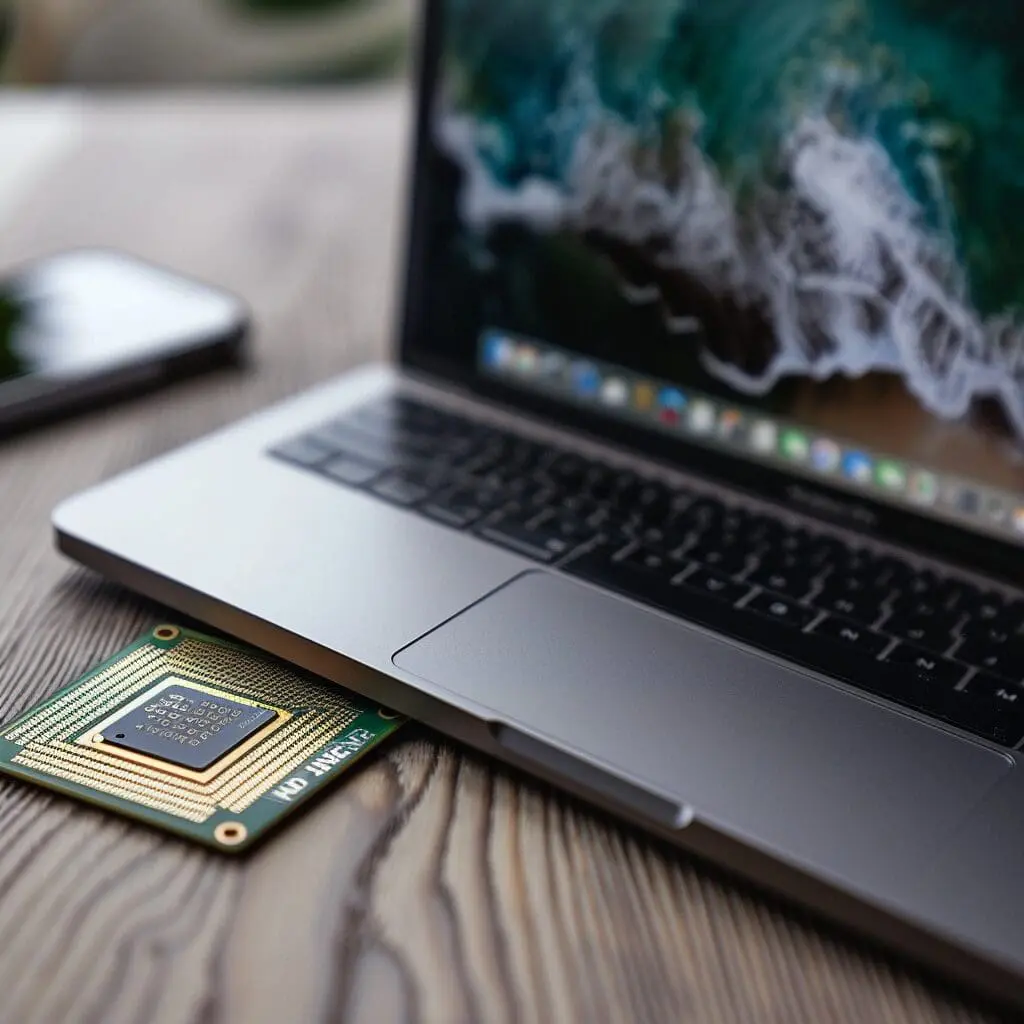

Apple today announced the discovery of the ‘GoFetch’ flaw within its M1, M2, and M3 silicon chips used in MacBook Air, causing concern in the tech community. This revelation unveils a critical vulnerability that threatens users’ digital security, impacting battery life. The microarchitectural weakness poses an unpatchable side-channel attack, potentially compromising encryption, even challenging the robustness of 2,048-bit keys designed for quantum resistance. Due to this flaw, sensitive data is at risk of being stolen directly from the cache by malicious applications exploiting GoFetch. This development highlights the fragility of constant-time programming defenses and emphasises the importance of immediate user action and developer intervention to mitigate risks. The tech community anticipates a lasting solution from Apple while recognising the significance of the neutral lid.
The ‘GoFetch’ flaw, identified in the Apple M1, M2, and M3 silicon chips, has uncovered a critical vulnerability, undermining the perceived invulnerability of Apple’s encryption technology. Operating as an unpatchable side-channel attack, this flaw directly jeopardises a wide range of encryption algorithms, overshadowing the security of even the most advanced 2,048-bit keys designed to counter potential quantum computing threats. The core of the flaw lies in its capacity to manipulate constant-time programming safeguards, thus empowering malevolent applications to extract sensitive data from cache memory. This revelation not only sparks significant concerns among users and developers but also illuminates the underlying issues of hardware security and the pressing need for mitigatory steps to be taken, as the tech community awaits an official software update from Apple.
The exposure of the ‘GoFetch’ vulnerability in Apple’s revered M series chips has brought attention to the critical importance of constant-time programming for Mac models. This programming method has traditionally been crucial in defending against timing and side-channel attacks, ensuring code execution independent of secret values. However, this flaw in the ‘GoFetch’ vulnerability highlights how sensitive data can be accessed and extracted from a device’s cache, bypassing these defences. It not only accentuates the evolving cyber threats but also stresses the necessity for robust security measures in hardware architecture, especially for MacBook Pro. This situation calls for a reassessment of current practices, memory needed, and underscores the need for innovative solutions to enhance the resilience of cryptographic protocols against advanced attacks, even in GPU cores, making it Apple’s biggest leap forward.
The intricate design of Apple’s M series chips, including the ‘GoFetch’ flaw, a microarchitecture vulnerability, has impacted the security of the laptop lid, revealing a significant security gap. This flaw affects the neutral engine, potentially risking user data. Beyond the facade of advanced encryption and security measures, there lies a critical weakness related to the headphone jack, where sensitive information can be illicitly extracted. The flaw exploits the microarchitectural design of the chips, affecting pro apps and enabling manipulation of data processing and storage in cache memory. Additionally, this vulnerability can impact hardware accelerated ray tracing. Attackers can leverage this flaw to bypass established cryptographic safeguards, potentially leading to the theft of personal and confidential data. The discovery of such a loophole underscores the urgent need for continuous advancements in chip security and encryption protocols to protect against vulnerabilities in evolving technology and the sophistication of cyber threats.
In response to the recently uncovered ‘GoFetch’ vulnerability within Apple’s M series chips, it’s crucial for both users and developers to take proactive measures to shield their devices and data from potential exploits. This involves keeping your software up to date to ensure you have the latest security patches from the Apple Store, adjusting the DOIT and DIT bits to disable the DMP on certain CPUs as a preventive measure, implementing input blinding in cryptographic practices to obscure the patterns in input data stored in local memory, and avoiding hardware sharing, which can provide an avenue for attacks. Apple claims that these strategies, coupled with the new MacBook Air’s unified memory architecture, form a robust defence mechanism against the exploitation of this critical vulnerability, guaranteeing the preservation of data integrity and security in an increasingly precarious digital landscape.
In response to the unsettling disclosure of the ‘GoFetch’ vulnerability impacting its M series chips, Apple has promptly provided guidance to mitigate data security risks. A key aspect of their advice involves adjusting the DOIT and DIT bits within the chip’s configuration, a move designed to prevent potential exploits. Apple recommends users modify these bits to disable the Direct Memory Access (DMA) Parsing (DMP) feature on specific CPUs, essential for thwarting malicious apps from exploiting vulnerabilities to access sensitive data. This reaction not only underscores Apple’s proactive approach to addressing security issues but also illuminates the intricate interaction of hardware features that, when optimally configured, can bolster device resilience against advanced cyber threats, including the neutral engine, audio and video calls, GPU cores, Final Cut, and previous generation.
Input blinding has emerged as a pivotal security technique in cryptography, gaining additional relevance in the context of the ‘GoFetch’ vulnerability plaguing Apple’s M1, M2, and M3 silicon chips, including the new MacBook Air. This process obscures the patterns in input data, acting as a countermeasure against side-channel attacks by complicating the task for malicious entities attempting to decipher confidential information, even when the laptop lid is closed. Particularly for Apple’s M series chips, which have been found susceptible to attacks exploiting microarchitectural vulnerabilities, input blinding can significantly reduce the risk of sensitive data exposure. This method disrupts the predictability of data being processed, addressing the critical loophole that the ‘GoFetch’ vulnerability seeks to exploit. In essence, input blinding reinforces the security of encryption algorithms, providing an essential layer of protection in safeguarding against the sophisticated techniques employed by attackers in today’s digital environment. Moreover, it enhances voice clarity, offers a full-height function row, and incorporates a neutral engine for improved security.
The recent focus on the ‘GoFetch’ vulnerability within Apple’s M series chips has shed light on the risks of hardware sharing in graphics architecture concerning cryptographic security. While these advanced chips excel in processing power and efficiency, their vulnerability to sophisticated side-channel attacks through shared hardware environments underscores the fine balance between performance and security. When multiple users or applications share the same physical hardware resources, as often seen in cloud computing scenarios, the risk of malicious exploitation like ‘GoFetch’ is heightened. This situation highlights the need to reassess the security implications of hardware sharing, especially for devices using cryptographic protocols prone to microarchitectural and timing attacks. It serves as a warning for manufacturers and users to prioritise robust security measures and consider the risks of shared environments in the design and usage of these advanced silicon devices, including their dynamic caching and main logic board.
The battle against vulnerabilities like ‘GoFetch’ in digital technology underscores the necessity for a collaborative approach among stakeholders, including manufacturers, software developers, cybersecurity experts, and end-users. Apple’s swift response to the ‘GoFetch’ vulnerability, through issuing guidance on adjusting DOIT and DIT bits and emphasising the importance of input blinding, provides a blueprint for proactive engagement. However, the effective mitigation of such threats demands more than just reactive measures; it requires a concerted effort to foster an ecosystem where continuous education, transparent communication, and shared responsibility prevail. By uniting these forces, we can collectively enhance the security infrastructure, deter malicious actors, and protect sensitive data against the evolving landscape of cyber threats. This collaborative stance not only strengthens our defence against current vulnerabilities but also prepares us for future challenges in the digital domain, leveraging the power of the Apple M3 chip, 8-core CPU, Apple M3 Pro, MacBook Pro in space grey, and the neutral chip.

This website uses cookies to improve your experience. Choose what you're happy with.
Required for the site to function and can't be switched off.
Help us improve the website. Turn on if you agree.
Used for ads and personalisation. Turn on if you agree.
This website uses cookies to improve your experience. Choose what you're happy with.
Required for the site to function and can't be switched off.
Help us improve the website. Turn on if you agree.
Used for ads and personalisation. Turn on if you agree.